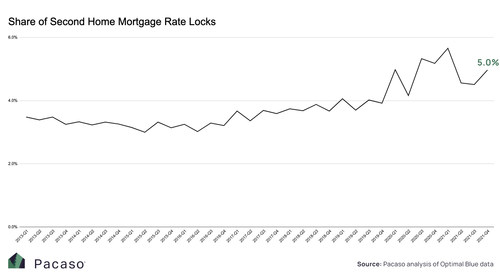Second home transactions are on the upswing again in Q4 2021 after receding in Q1 2021, according to Pacaso, a real estate marketplace that helps people buy and co-own a second home.
The Pacaso Second Home Market Report, offers data on property use and mortgage rate locks. It includes counties whose percentage of seasonal homes and median home values are both at or above the top 20th percentile. According to the press release, mortgage rate lock data is a leading indicator of second home buying activity.

The report shows that in Q1 2021, the percentage of second home mortgage rate locks hit its highest recorded level, with the share of second home transactions reaching 5.7%.
In the two subsequent quarters, the percentage of second home rate locks decreased to 4.6% in Q2, and to 4.5% in Q3. But the share of second home transactions rebounded in Q4, reaching 5%.
“Looking back at this past year, we saw the percentage of second home sales decrease in the second and third quarter, after peaking in the first three months of last year,” said Pacaso CEO Austin Allison. “In April of last year, however, people stopped to take a beat, to see how things would shake out in what everyone hoped would be a post-pandemic reality. For some, that also meant going back to the office, and perhaps not coincidentally, second-home sales started to slow. But these last few months, many employers finally decided to make remote work more permanent. This seems to have spurred renewed interest in second home ownership.”
Increases in Southeast
Most markets with the largest year-over-year increases in second home mortgage rate locks were located in the Southeast U.S., the report found. Sumter County, Florida, between Orlando and Tampa, saw the largest national increase in second home rate lock transactions, with a 65% year-over-year increase.
“For the past year we’ve been tracking up-and-coming second home hot spots,” said Allison. “And actually, Sumter is a perfect example of the kinds of locations we call ‘vacation-destination-adjacent’ that have been catching our eye. If established second-home destinations are like Broadway, these emerging nearby destinations are like Off-Broadway, and their moment in the limelight–or the sunshine–is coming.”
St. John’s County in Florida also saw an increase in transactions, with second-home mortgage rate locks up 9.7% year over year in Q4. One of the county’s notable cities is St. Augustine, located just south of Jacksonville. St. Augustine is known for being the nation’s oldest city, and is often referred to as The Ancient City because of its historical landmarks and cobblestone streets that date back to the late 1500s.
43 of the 50 counties tracked in Pacaso’s report saw double-digit price growth in second home prices in Q4. Mono County, California, which borders Yosemite National Park, topped the charts in terms of price growth, with a median purchase price of $790K, up an astonishing 83.7% compared to a year ago.
That increase is likely driven by the confluence of several factors, including the area’s extraordinary endowment of natural beauty, its relative proximity to expensive West Coast population centers, and limited new construction. The latter is in stark contrast to some other second home hotspots, like those in Florida, which have seen more significant development.
Atlantic County, New Jersey, home to Atlantic City, saw the biggest annual declines in second home median sale prices, down 14%. New Jersey has been particularly susceptible to foreclosures, and according to Attom data, New Jersey counties had the third-highest amount of foreclosures in the country in Q4 (1 in every 1,288 units).



